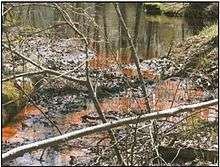Bog iron
 Bog ore  Part of Wall with Hermai—usage of bog ore in architecture  Picture of typical iron-bearing ground water emerging as a spring. The iron is oxidized to ferric hydroxide upon encountering the oxidizing environment of the surface. A large number of these springs and seeps on the flood plain provide the iron for bog iron deposits. |
Bog iron is a form of impure iron deposit that develops in bogs or swamps by the chemical or biochemical oxidation of iron carried in solution. In general, bog ores consist primarily of iron oxyhydroxides, commonly goethite (FeO(OH)).
Iron-bearing groundwater typically emerges as a spring. The iron is oxidized to ferric hydroxide upon encountering the oxidizing environment of the surface. Bog ore often combines goethite, magnetite and vugs or stained quartz. Oxidation may occur through enzyme catalysis by iron bacteria. It is not clear whether the magnetite precipitates upon first contact with oxygen, then oxidizes to ferric compounds, or whether the ferric compounds are reduced when exposed to anoxic conditions upon burial beneath the sediment surface and reoxidized upon exhumation at the surface.
Iron made from bog ore will often contain residual silicates, which can form a glassy coating that grants some resistance to rusting.
Europe and the North
Iron smelting from bog iron was invented during the Pre-Roman Iron Age, and most Viking era iron was smelted from bog iron. The bog iron deposits of Northern and Northeastern Europe were created after the Ice Age ended, on postglacial plains. In Russia, bog ore was the principal source of iron until the 16th century, when the superior ores of Ural Mountains became available.
"Streams carry dissolved iron from nearby mountains. In the bog, the iron is concentrated by two processes. The bog environment is acidic, with a low concentration of dissolved oxygen. In the acidic environment of the bog, a chemical reaction forms insoluble iron compounds which precipitate out. But more importantly, anaerobic bacteria (Gallionella and Leptothrix) growing under the surface of the bog concentrate the iron as part of their life processes...Their presence can be detected on the surface by the iridescent oily film they leave on the water (left), another sure sign of bog iron. In Iceland, the film is called jarnbrák (iron slick). When a layer of peat in the bog is cut and pulled back using turf knives, pea sized nodules of bog iron can be found and harvested. Although the iron nodules are reasonably pure, there aren't many of them. They are, however, a renewable resource. About once each generation, the same bog can be re-harvested."[1]
Colonial North America
Bog iron was widely sought in colonial North America. The first mining efforts occurred in Virginia as early as 1608. In 1619 Falling Creek Ironworks was established in Chesterfield County, Virginia. It was the first iron production facility in North America and location of the first blast furnace.[2][3] Lake Massapoag in Massachusetts was drawn down by deepening the outlet channel in a search for bog iron.[4] The Saugus Iron Works National Historic Site, on the Saugus River in Saugus, Massachusetts operated between 1646 and 1668.
The site contains a museum and several reconstructed buildings.[5] The success of the Saugus Iron Works, and the rapid depletion of the region's natural bog iron, led them to send prospectors into the surrounding countryside. In 1658 they bought 1,600 acres (6.5 km2) of land which covered areas that are now Concord, Acton, and Sudbury. They set up a large production facility in Concord, Massachusetts, along the Assabet River with dams, ponds, watercourses and hearths, but by 1694 the natural bog iron there had also been exhausted, and the land was sold for farming.[6]
In New Jersey, bog ore was mined and refined in Central and Southern New Jersey for the production of tools and wrought iron rails (many of which still grace stairs in Trenton and Camden), which take advantage of its natural rust resistance. During the American Revolution, the iron was used for cannon balls for the American colonial forces.
Bog iron was also found on the Eastern Shore of Maryland. The remains of a commercial smelting operation near Snow Hill, Maryland are now a state and national historic site. Known as Furnace Town, it was called the Nassawango Iron Furnace after the nearby creek. The commercial furnace ran from about 1825 to 1850.
See also
- Limonite
- Iron ore
- Ore genesis
- Acidithiobacillus ferrooxidans (iron-oxidizing bacteria)
- History of ferrous metallurgy
References
- ↑ "Iron Production in the Viking Age". Hurstwic. Retrieved 27 August 2015.
- ↑ JSTOR 4246864
- ↑ http://www.history.org/foundation/journal/autumn07/iron.cfm
- ↑ Diana Muir, Reflections in Bullough's Pond, University Press of New England, 2000.
- ↑ http://www.nps.gov/sair/index.htm Saugus Iron Works
- ↑ http://www.concordma.com/magazine/maraprmay02/ironworks.html The Concord Iron Works
External links
| Wikimedia Commons has media related to Bog iron. |
- ASME PDF file with detailed reconstruction drawings of the furnace and surroundings.
- Nassawango Furnace at the Maryland Historic Trust.
-
 "Bog Ore". The American Cyclopædia. 1879.
"Bog Ore". The American Cyclopædia. 1879.